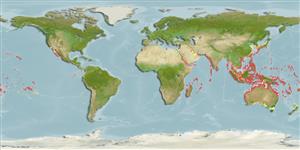Common names from other countries
Environment: milieu / climate zone / depth range / distribution range
Écologie
; profondeur 10 - 30 m (Ref. 337). Tropical
Indo-Pacific.
Length at first maturity / Taille / Poids / Âge
Maturity: Lm ? range ? - ? cm Max length : 8.0 cm SHL mâle / non sexé; (Ref. 349); common length : 6.5 cm SHL mâle / non sexé; (Ref. 349)
Collected by coastal populations in the tropical West Pacific for food and shell trade (Ref. 349). Often very common (Ref. 349). Found at depths of 10 to 30 m, on alga-covered rock (Ref. 337), and on coral reef flats on coral atolls and in tide pools on thin alga-sand bottom (Ref. 87884).
Life cycle and mating behavior
Maturité | Reproduction | Frai | Œufs | Fécondité | Larves
Members of the order Neotaenioglossa are mostly gonochoric and broadcast spawners. Life cycle: Embryos develop into planktonic trocophore larvae and later into juvenile veligers before becoming fully grown adults.
Poutiers, J.M. 1998. (Ref. 349)
Statut dans la liste rouge de l'IUCN (Ref. 130435)
statut CITES (Ref. 108899)
Not Evaluated
Not Evaluated
Menace pour l'homme
Harmless
Utilisations par l'homme
Pêcheries: commercial
| FishSource |
Outils
Plus d'informations
Taille/ÂgeCroissanceLongueur-poidsLongueur-longueurMorphologieLarvesAbondance
Sources Internet
Estimates based on models
Preferred temperature
(Ref.
115969): 23.8 - 29, mean 27.8 (based on 432 cells).
Vulnérabilité
Low vulnerability (10 of 100).
Catégorie de prix
Unknown.
